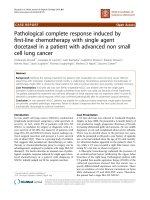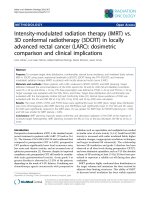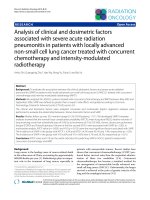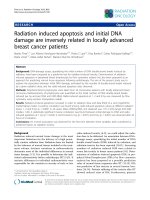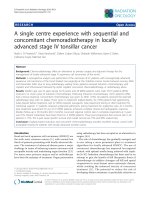Concurrent chemoradiotherapy with tomotherapy in locally advanced non-small cell lung cancer: A phase i, docetaxel dose-escalation study, with hypofractionated radiation regimen
Bạn đang xem bản rút gọn của tài liệu. Xem và tải ngay bản đầy đủ của tài liệu tại đây (458.53 KB, 7 trang )
Bearz et al. BMC Cancer 2013, 13:513
/>
RESEARCH ARTICLE
Open Access
Concurrent chemoradiotherapy with tomotherapy
in locally advanced non-small cell lung cancer: a
phase i, docetaxel dose-escalation study, with
hypofractionated radiation regimen
Alessandra Bearz1*, Emilio Minatel2, Imad Abu Rumeileh2, Eugenio Borsatti3, Renato Talamini4, Giovanni Franchin2,
Carlo Gobitti2, Alessandro Del Conte5, Marco Trovò2 and Tanja Baresic3
Abstract
Background: Concurrent chemo-radiotherapy is demonstrately superior to sequential chemo-radiotherapy in the
treatment of advanced Non-Small-Cell Lung Cancer not suitable for surgery. Docetaxel is considered to enhance
the cytotoxic effect of radiotherapy on the tumour cells. Tomotherapy (HT) is a novel radiotherapeutic technique,
which allows the delivery of Image Guided-IMRT (IG-IMRT), with a highly conformal radiation dose distribution.
The goal of the study was to estimate tolerability of Docetaxel concurrent with IMRT and to find the maximum
tolerated dose of weekly Docetaxel concurrent with IMRT delivered with HT Tomotherapy after induction
chemotherapy with Cisplatin and Docetaxel in patients affected with stage III Non-Small Cell Lung Cancer.
Methods: We designed a phase I, dose-finding study to determine the dose of weekly Docetaxel concurrent
with Tomotherapy after induction chemotherapy, in patients affected by Non-Small Cell Lung Cancer with Stage
III disease, not suitable for surgery.
Results: Concurrent weekly Docetaxel and Tomotherapy are feasible; we did not reach a maximum tolerated
dose, because no life-threatening toxicity was observed, stopping the accrual at a level of weekly docetaxel
38 mg/m2, a greater dose than in previous assessments, from both phase-I studies with weekly docetaxel alone
and with Docetaxel concomitant with standard radiotherapy.
Conclusions: Concurrent weekly Docetaxel and Tomotherapy are feasible, and even with Docetaxel at
38 mg/m 2/week we did not observe any limiting toxicity. For those patients who completed the combined
chemo-radio treatment, median progression-free survival (PFS) was 20 months and median overall survival
(OS) was 24 months.
Background
Concurrent chemo-radiotherapy is considered the standard
treatment for patients affected by locally advanced, stage
III, unresectable Non-Small Cell Lung Cancer (NSCLC)
and good performance status (PS) [1]. Stage III NSCLC
constitutes a heterogeneous group, likely due to a different
nodal involvement; its median survival has been recently
updated from 12 to 23.3 months in phase III trials [2,3].
* Correspondence:
1
Medical Oncology Department, National Cancer Institute of Aviano (PN),
Aviano (PN), Italy
Full list of author information is available at the end of the article
The recommended systemic treatment in stage III NSCLC
consists of 2–4 cycles of platin-combination with concurrent radiotherapy [4]. In an effort to improve overall survival (OS) different schemes for both induction and
consolidation therapy are used in clinical practice, with induction chemotherapy before the start of concurrent
chemo-radiotherapy preferred by some [2,5] and consolidation modalities preferred by others [3,6]. However, no
clear superiority has been demonstrated between those
two approaches. Docetaxel enhances the cytotoxic effects of radiotherapy in vitro [7]. In several phase II
studies radiotherapy with concurrent Docetaxel and
© 2013 Bearz et al.; licensee BioMed Central Ltd. This is an open access article distributed under the terms of the Creative
Commons Attribution License ( which permits unrestricted use, distribution, and
reproduction in any medium, provided the original work is properly cited.
Bearz et al. BMC Cancer 2013, 13:513
/>
after induction with Cisplatin-Docetaxel combinations
has been shown to be feasible [8,9], with encouraging
OS rates. There is an indication that higher radiation
doses may result in improved probability of local
tumour control [10]; however, using current radiation
delivery techniques dose escalation, in particular in
combination with chemotherapy, may lead to unacceptable lung toxicity. Therefore, the search for better radiotherapy approaches is important and Tomotherapy (HT)
may be one of the most promising technologies for this
purpose [11]. HT is a novel technique, which allows the
delivering of Image Guided - IMRT (IG-IMRT), by using
a dynamic delivery in which gantry, treatment couch, and
multileaf collimator leaves are all in motion during treatment, resulting in a highly conformal radiation dose distribution [12]. The development of those techniques has led
to improved radiation delivery with better tumor coverage
and decreased exposure of surrounding normal tissues;
however, in the CALBG 30105 study [13] the arm with
Gemcitabine concurrent with high dose conformal radiation treatment was closed for high rate of severe pulmonary toxicities, likely due to larger mean lung doses;
however the authors suggest that radiosensitizing properties of Gemcitabine on normal tissue may have contributed to the higher pulmonary toxicity observed [14]. On
this basis, we were concerned that, using a radiosensitizer
agent such as Docetaxel concurrent with Tomotherapy,
with larger volumes of healthy lung treated with low dose
radiation, could lead to a different maximum tolerated
dose (MTD) for Docetaxel.
We designed a phase I, dose-finding study to estimate
the tolerability of concurrent Docetaxel with Tomotherapy and to determine the MTD of weekly Docetaxel
concurrent with IMRT delivered with HT after induction
chemotherapy. We chose to study Docetaxel alone combined with concurrent HT, because Docetaxel may enhance both activity and toxicity of radiotherapy and we
did not want to have any confounding bias in the results
analysis. For this reason we chose to deliver the backbone of systemic treatment for NSCLC, i.e. platinum, in
the induction part, using Docetaxel alone in the concurrent study.
Methods
This was a mono-institutional, phase I, dose-finding study.
Enrolment started in March 2008 and was closed in
June 2011. Eligible patients were male or non-pregnant
and non-breast feeding females, aged more than 18 years,
PS ECOG 0 or 1, with histologically or cytologically confirmed NSCLC with multiple clinical-level N2 or N3 for
mediastinal lymph nodes, above the 15 mm short-axis
threshold at Computed Tomography (CT) scanning. Patients with supraclavicular involvement of lymph nodes
and pleural effusion were excluded. Fluoro-2-deoxy-D-
Page 2 of 7
glucose-positron emission tomography (FDG-PET) fusions with CT (PET-CT), as well as CT-scans of the
thorax, blood tests and pulmonary function tests were
mandatory at baseline. Patients must have adequate organ
function including the following: bone marrow reserve
(white blood cell count ≥3.0 × 109/L, absolute neutrophils
count ≥1.5 × 109/L), hepatic function (bilirubin ≤1.5 times
upper limits of normal [x ULN] and alkaline phosphatase,
aspartate transaminase and alanine transaminase ≤2.5 ×
ULN), and renal function (serum creatinine ≤1.5 × ULN).
Screening assessments were carried out within 28 days of
the first dose of chemotherapy. The treatment protocol
was reviewed and approved by the competent authorities
and the institutional ethics committee and was registered
with the authorities (European Union Drug Regulating
Authorities Clinical Trial no. EUDRACT 2008-00107433). Each patient signed an informed consent document.
Treatment plan
In the induction part all patients received three cycles of
Cisplatin 80 mg/ m2 and Docetaxel 75 mg/m2 on day 1,
every three weeks. A PET-CT scan was repeated after
the third cycle and patients with stable disease or partial/complete response were included in the phase I
radiotherapy concurrent with chemotherapy protocol.
The phase I, dose-escalation trial consisted of 5 weeks of
once-weekly Docetaxel (on day 3 of every week) concurrent with radiotherapy at a dose of 2,4 Gy/day for
5 days/week for 5 consecutive weeks to a total dose of
60 Gy. Docetaxel dosage was scheduled as 10 mg/m2
weekly for the first 3 patients; if no severe toxicity occurred, the next 3 patients were to be treated with Docetaxel 13 mg/m2/week, and so on according to a modified
Fibonacci 3 + 3 design [15]. The dose was escalated in
cohorts of 3 patients and 3 mg/m2 were added to every
cohort. The choice to add 3 mg/m2 at each cohort instead of the 67% of the starting dose like in Fibonacci
design was due to the absence of information about HT
concurrent to chemotherapy. At the time this protocol
was planned, it was only known the dose limitation of
30 mg/m2/week for Docetaxel concomitant with radiotherapy [16]; for this reason the dose was increased with
caution. Dose-limiting toxicities were defined as grade
(G) 4 thrombocytopenia, or at least G2 bleeding, G4
neutropenia, or febrile neutropenia, G3 nausea, vomiting
or diarrhoea; unexpected G2 toxic effects needing dose
reduction or delay in the concurrent treatment were also
classified as dose limiting. In the case of at least one severe toxicity, 3 more patients had to be added at that
level and, if again severe toxicity occurred within the
same cohort, that dose was to be considered the maximum tolerated dose, with the previous level chosen as
the dose to use in concurrent modality with HT. Adverse events were graded according to National Cancer
Bearz et al. BMC Cancer 2013, 13:513
/>
Institute Common Terminology Criteria for adverse events
(version 3.0) [17].
Chemotherapy
Docetaxel was administered in a 60-minute i.v. infusion,
both in induction (75 mg/m2 every three weeks) and
concurrent therapy (weekly and with dose-escalation).
The standard prophylaxis to prevent hypersensitivity reactions included a single intravenous administration of
corticosteroids and histamine-blocking drugs just before
Docetaxel infusion. Induction Cisplatin 80 mg/m2 was
administered as a 60-minutes i.v. infusion immediately
following the Docetaxel infusion. Hydration and prophylactic antiemetics were administered before chemotherapy. In the induction part dose modifications allowed
due to toxicity were: Docetaxel 75% for febrile neutropenia,
G4 neutropenia, febrile neutropenia, G4 thrombocytopenia,
G ≥3 mucositis; and Cisplatin 75% for nephrotoxicity G ≥ 2.
Concurrent chemo-radiotherapy
No dose modifications for Docetaxel in concurrent modality were allowed. Docetaxel was administered on day
3 every week of radiotherapy, and thoracic radiotherapy
was started 30 minutes after infusion.
Radiotherapy
Patients underwent a volumetric treatment-planning CT
scan using an individualized immobilization device in
the treatment position on a flat table. The gross tumour
volume (GTV), planning target volume (PTV) and planning organ at risk volume (PRV) were delineated according to the International Commission on Radiation Units
and Measurements (ICRU) Report 62 guidelines. The restaging FDG-PET/CT performed before radiation therapy was co-registered to the treatment-planning CT to
improve the target delineation. The GTV included the
primary tumour and any FDG-avid regional lymph
nodes. For this study, the clinical target volume was
equivalent to the GTV. Elective nodal regions were not
intentionally irradiated. The PTV volume included the
GTV with a minimal 3D margin of 10 mm. A 4D CTscan was used to check GTV and PTV margins with respect to physiologic ventilatory tumour excursion. The
dose prescribed to the PTV was 60 Gy delivered in 25
fractions (2.4 Gy/fraction), so that 95% of the PTV received the 98% of the prescribed dose. Using the linear
quadratic model and the BED equation derived from this
model, assuming an α/β ratio of 10 Gy, this prescription
would be equivalent to 66 Gy in a standard 2-Gy fractionation [18,19]. There are two modalities of shortening
overall time of radiotherapy without increasing late complications and allowing for better efficacy outcomes: first
is two fractions per day, second is using fewer and larger
doses [20,21]. We used a relatively hypofractionated
Page 3 of 7
radiation regimen based on the second modality. Specific dosimetric guidelines were the following: spinal
cord maximum dose <46 Gy; mean lung dose <14 Gy;
lung V20 (percentage of lung receiving 20 Gy) <25%.
Treatment was delivered once a day, five fractions
weekly. All patients were treated with HT [11]. A Megavolt CT-scan was also performed daily for each patient to
image-guide the radiation treatment, no adaptive radiotherapy was performed. Patients were seen weekly during
the radiotherapy course to determine the presence of
symptoms.
Patient evaluation
All patients underwent a full physical examination (including determination of performance status, weight
loss, vital signs), and haematological test at baseline and
then weekly during induction and concurrent therapy.
They also underwent a biochemistry test at baseline and
every 3 weeks during induction and concurrent treatment. Chest CT was mandatory and brain CT was performed if clinically indicated; all patients had multi-level
N2 or N3 involvement demonstrated both by CT scan
and PET-CT. Tissue or cytologic diagnosis was made
using biopsy/brushing or bronchial aspirate obtained
during fibre-optic bronchoscopy or, alternatively, transthoracic aspiration biopsy of the primary tumour. CT-PET
scan was performed ≤2 weeks before starting induction
chemotherapy and local chemo-radiotherapy, respectively,
and was repeated every 4 months during follow-up, starting two months after the end of concomitant treatment.
PET/CT scans were performed using a combined PET
and CT system (Discovery LS PET CT, GE Healthcare,
Milwaukee, WI, USA). Patients were fasting for at least
6 hours before tracer injection and each patient received
350–400 MBq of FDG (18 F-Fluoro-2-deoxy-D-glucose)
intravenously. PET/CT acquisitions were carried out at
60 minutes post tracer-injection, after the patients
waiting for the scan were kept at rest in a quiet, dimly
lit room. A whole-body PET/CT scan, consisting of
helical CT scanning from the head through the pelvis
(rotation time 0.8 s, slice thickness 5 mm, image interval 4.25 mm, X-ray voltage 140 kV and X-ray current
80–140 mA), followed by a 2D PET acquisition (six or
seven bed positions at 5 min per bed position) was performed in all patients. Immediately after being acquired,
images were reconstructed using ordered subsets expectation maximization 2D iterative reconstruction; CT images were used to produce attenuation correction values
for PET emission reconstruction and fused PET/CT presentation, in order to avoid misinterpretation between
inflammatory pathology and tumour. PET data were
interpreted independently of the result of any prior investigation by two nuclear medicine physicians in consensus, expert in oncological imaging. Any focal FDG
Bearz et al. BMC Cancer 2013, 13:513
/>
uptake in a pulmonary lesion or in a mediastinal node
higher than the surrounding background activity was
used as a PET criterion for malignancy. In particular,
high focal lung tracer uptake was interpreted as cancer
uptake in disease staging and as persistent disease in
re-staging. Focal activity in mediastinal lymph nodes
was considered as metastatic disease when consistent
with an abnormal volumetric size by CT-scan. Assessment of FDG uptake was made visually, comparing
PET/CT studies of the same patient, considering the
visual increasing or decreasing FDG uptake in the lesions
together with RECIST morphological criteria of response.
The standardized uptake value of FDG uptake (SUV) was
used as an accessory reference only. The results of
PET-CT were then classified as progressive disease,
stable disease, or partial and complete remission in according to both PET visual FDG uptake analysis and CT
morphological criteria.
The primary endpoint was safety and toxicity of Docetaxel concurrent with Radiation Therapy after induction
treatment in order to define the maximum dose level.
Any treatment-related side effects were followed until
resolution. Tumour response was assessed according to
RECIST criteria 3.0 [22].
The efficacy of treatments was evaluated in all patients
who were allocated to induction treatment; response rate
was recorded and follow-up for progression free survival
(PFS) and overall survival (OS) was maintained till progression and death for all patients who completed the
induction and concurrent treatment. Kaplan-Meier
methods were used to assess PFS and OS [23].
Results
The first patient was enrolled in January 2008, the last
one in January 2011. Analysis was done in June 2012; a
total of 37 patients were treated. Four patients (10%) out
of 37 did not go into the concurrent chemo-radiotherapy,
2 because of progression of disease after the induction
therapy and 2 because of consent withdrawal. Patients’
characteristics are summarized in Table 1. Seven patients
were female (19%) and 30 males (81%); median age was
61 years (range 40–77), 16 patients were affected by squamous cell carcinoma (43%) and 20 by adenocarcinoma
(54%); one patient (3%) had an undifferentiated histology.
For 23 patients only EGFR mutational analysis was possible, and only one patient (4%) harboured a mutation at
exon 21. About Performance Status according to ECOG
scale at diagnosis, 22 patients (60%) had PS 0, and 15
(40%) had PS 1. Fifteen patients (40%) had stage IIIA and
22 (60%) IIIB disease. Docetaxel was reduced at 75% of
the planned dose for toxicity in 4 patients (11%) during
the induction treatment: 2 patients showed mucositis G3,
one patient had nausea G3 and one patient suffered from
atrial fibrillation. During induction therapy, 5 patients
Page 4 of 7
Table 1 Demographics of 37 patients
Patients (%)
Median age (years)
61 (44–77)
Sex
Females
7 (19)
Males
30 (81)
Histology
Squamous
16 (43)
Adenocarcinoma
20 (54)
Undifferentiated (NOS)
1 (3)
PS ECOG
0
22 (60)
1
15 (40)
IIIA
15 (40)
IIIB
22 (60)
Stage
(13%) reported neutropenia G3, and 3 (8%) neutropenia G4 without fever. G-CSF was used as primary
prophylaxis in 11 patients (30%), from cycle II in the
induction treatment. No thrombocytopenia or anaemia
greater than G1 was recorded. Three patients had nausea G3 and one patient reported diarrhoea G3 in the
induction phase. All 37 patients were evaluable for response to induction chemotherapy: the ORR was 31/37
(84% all partial responses), 2 progressive diseases (5%),
and 4/37 patients were stable (10%). Thirty-three patients were subsequently enrolled into the phase I dose
escalation study, with concurrent chemo-radiotherapy.
All 33 patients received the planned radiotherapy total
dose of 60 Gy and weekly Docetaxel; each cohort received 3 mg/m2 more of weekly docetaxel, starting
Table 2 Dose-level evaluation of 33 patients
Dose
level
Weekly docetaxel
(mg/m2/week)
N. of patients
with DLT/treated
patients
1
10
0/3
2
13
1/6
3
16
0/3
4
19
0/3
5
22
0/3
6
25
0/3
7
28
0/3
8
31
0/3
9
35
0/3
10
38
0/3
DLT
Grade 3
esofagitis
Bearz et al. BMC Cancer 2013, 13:513
/>
Page 5 of 7
Figure 1 Progression free survival of 33 patients with lung cancer, stage III, not operable and treated with induction chemotherapy
and radiotherapy.
20 months (Figure 1). Median OS for the 33 patients
who received both induction chemotherapy and concomitant chemo-radiotherapy was 24 months (Figure 2).
Discussion
The treatment of locally advanced NSCLC has been a
controversial issue. It has been well established that concurrent chemo-radiotherapy with Etoposide and Cisplatin improves survival compared with radiation alone
[1] and it is considered the standard of treatment for locally advanced NSCLC. Many other strategies have been
tried in order to overcome the achieved survival plateau,
established around a median 17 months [1]. To date, no
randomized comparisons of consolidation chemotherapy
versus observation after concurrent chemo-radiation have
shown a survival benefit in locally advanced NSCLC
[3,25]. The induction chemotherapy strategy has several
theoretical advantages, such as increasing the sensitivity of
P
from 10 mg/m2 to 38 mg/m2 (Table 2). No life-threatening
haematological toxicities were recorded in the concurrent
treatment, 2 patients had leucopoenia G2; radiation pneumonitis were never reported; no patient reported diarrhoea; esophagitis was G2 in 7/33 patients (21%), and G3
in one patient (3%). No late oesophageal toxicity was observed. Docetaxel dose-escalation followed the standard
3 + 3 rule, starting from 10 mg/m2/week. In the absence of dose-limiting toxicity (DLT), we decided to
stop at a dose of 38 mg/m2/week, a greater dose than
previous assessments in phase-I studies with weekly
docetaxel alone [24].
Response at the first PET-CT scan after the end of
concurrent chemo-radiotherapy was as follows: 28 patients (85%) showed a partial response, 2 patients (6%)
had a progression of disease, 2 patients were stable (6%).
Median PFS was calculated for 33 patients who completed the combined chemo-radio treatment, and it was
Figure 2 Overall survival of 33 patients with lung cancer, stage III, not operable and treated with induction chemotherapy
and radiotherapy.
Bearz et al. BMC Cancer 2013, 13:513
/>
tumours in early-stage disease, decreasing the tumour volume to enable a better local control by radiation, allowing
faster eradication of micro-metastatic disease. Several randomized phase II studies were conducted in order to explore the efficacy of induction chemotherapy followed by
concurrent chemo-radiation versus concomitant treatment followed by consolidation chemotherapy; however
no statistically significant differences were observed [2,26].
The introduction of taxanes, Gemcitabine and Vinorelbine
in combinations with platin compounds as well as the
introduction of new techniques of radiotherapy may improve the therapeutic efficacy of chemo-radiation combination; nevertheless, the optimal combination, dose intensity,
strategy or timing is still to be defined. In order to study the
feasibility of concurrent chemotherapy with HT, a highly
conformal, new radiation technique, we decided to associate
Docetaxel, known as radio-sensitizing chemotherapeutic
agent. Our goal was to perform a dose-finding study to individuate the maximum tolerated (MTD) dose of Docetaxel
when associated with HT, assuming that MTD could be different from the one already known of Docetaxel concurrent
with standard radiation therapy. In order to avoid confounding bias, we decided not to associate Docetaxel with Cisplatin during the concomitant treatment. Being that it is not
ethical to treat patients without Cisplatin, we decided to
offer them an induction treatment with three cycles of Cisplatin and Docetaxel before concurrent chemo-radiation, although a previous phase III study by Vokes EE et al. had
already stated that induction chemotherapy does not add a
significant survival benefit over concurrent therapy alone
[2]. For this reason, we decided that patients after receiving
three cycles of induction with Cisplatin and Docetaxel were
treated with radiation therapy concurrent with weekly Docetaxel, within a dose-finding study for the weekly Docetaxel.
All the patients had multi-level N2 or N3 lymph nodal involvement, confirmed mostly by a non invasive modality,
both CT-scan and PET-CT. In a recent meta-analysis, PET
scanning was superior to CT scanning in the detection of
nodal metastatic disease, with sensitivity of 83% and specificity of 92% [27]. In an attempt to determine the need for invasive staging like mediastinoscopy after PET and CT
imaging, a meta-analysis evaluated the association between
the size of mediastinal lymph nodes and the probability of
malignancy [28]. The authors concluded that the prevalence
of metastasis strongly increases above the 15 mm short-axis
threshold at CT scanning, positioning the need for mediastinoscopy only in patients with nodes measuring <15 mm on
CT and negative on FDG-PET or with hilar involvement of
the tumour. We decided to include only patients with
nodes > 15 mm short-axis at CT-scanning and positive on
FDG-PET, and for this reason we do not performed mediastinoscopy at staging.
We did not reach a maximum tolerated dose, because
no life-threatening toxicity was observed. We decided to
Page 6 of 7
stop the accrual early at a level of weekly docetaxel
38 mg/m2, that being a greater dose than in previous assessments, from both phase-I studies with weekly Docetaxel alone and with Docetaxel concomitant with standard
radiotherapy. To our knowledge this is the first study of
Tomotherapy with weekly concurrent chemotherapy in a
dose escalation study of Docetaxel, in the treatment of
NSCLC. There was a previous published study of
Tomotherapy and concurrent chemotherapy, with fixed
dose of chemotherapy, Cisplatin and Docetaxel at a dose
of 20 mg/m2/weekly, each administered weekly and with
radiotherapy fraction size escalation [29]. Although it was
not a primary endopoint for this study, the PFS and OS of
the patients recruited in the study are encouraging, well
above the median data obtained in the previous studies
with chemo-radiation for locally advanced NSCLC; however they need further validation through phase II, multiinstitutional studies and eventually comparative phase III
trials.
Conclusion
Tomotherapy and concurrent chemotherapy with Docetaxel is feasible in advanced NSCLC patients and warrants further multi-institutional validation trials.
Competing interests
The authors declare that they have no competing interests.
Authors’ contributions
AB, EM, GF, AIR, CG, ADC, MT carried out the clinical work, EB and TB
performed the imaging analyses, RT carried out the statistical analyses, AB
drafted the manuscript. All authors read and approved the final manuscript.
Author details
1
Medical Oncology Department, National Cancer Institute of Aviano (PN),
Aviano (PN), Italy. 2Radiation Oncology Department, National Cancer Institute
of Aviano (PN), Aviano (PN), Italy. 3Nuclear Medicine Department, National
Cancer Institute of Aviano (PN), Aviano (PN), Italy. 4Division of Epidemiology
and Biostatistics, National Cancer Institute of Aviano (PN), Aviano (PN), Italy.
5
General Hospital, Pordenone, Italy.
Received: 31 May 2013 Accepted: 27 October 2013
Published: 31 October 2013
References
1. Aupérin A, Le Péchoux C, Rolland E, et al: Meta-analysis of concomitant
versus sequential radiochemotherapy in locally advanced non-small-cell
lung cancer. J Clin Oncol 2010, 28:2181–2190.
2. Vokes EE, Herndon JE 2nd, Kelley MJ, et al: Induction chemotherapy
followed by chemoradiotherapy compared with chemoradiotherapy
alone for regionally advanced unresectable stage III Non-small cell lung
cancer: Cancer and Leukemia Group B. J Clin Oncol 2007, 25:1698–1704.
3. Hanna N, Neubauer M, Yiannoutsos C, et al: Phase III study of cisplatin,
etoposide, and concurrent chest radiation with or without consolidation
docetaxel in patients with inoperable stage III non-small cell lung cancer:
the Hoosier Oncology Group and U.S. Oncology. J Clin Oncol 2008,
26:5755–5760.
4. Pfister DG, Johnson DH, Azzoli CG, et al: American Society of Clinical
Oncology treatment of unresectable non-small cell lung cancer guideline:update 2003. J Clin Oncol 2004, 22:330–353.
5. Van Meerbeeck JP, Kramer GW, Van Schil PE, et al: Randomized controlled
trial of resection versus radiotherapy after induction chemotherapy in
stage IIIA-N2 non-small cell lung cancer. J Natl Cancer Inst 2007,
99:442–450.
Bearz et al. BMC Cancer 2013, 13:513
/>
6.
7.
8.
9.
10.
11.
12.
13.
14.
15.
16.
17.
18.
19.
20.
21.
22.
23.
24.
25.
26.
27.
Gandara DR, Chansky K, Albain KS, Southwest Oncology Group, et al:
Consolidation docetaxel after concurrent chemoradiotherapy in stage
IIIB non-small-cell lung cancer: phase II Southwest Oncology Group
Study S9504. J Clin Oncol 2003, 21:2004–2010.
Mason KA, Kishi K, Hunter N, et al: Effect of docetaxel on the
therapeutic radio of fractionated radiotherapy in vivo. Clin Cancer Res
1999, 5:4191–4198.
Betticher DC, Hsu Schmitz SF, Totsch M, et al: Mediastinal lymph node
clearance after docetaxel-cisplatin neoadjuvant chemotherapy is prognostic of survival in patients with stage IIIA pN2 non-small cell lung cancer: a multicenter phase II trial. J Clin Oncol 2003, 21:1752–1759.
Scagliotti GA, Szczesna A, Ramlau R, et al: Docetaxel-based induction
therapy prior to radiotherapy with or without docetaxel for non-small
cell lung cancer. Br J Cancer 2006, 94:1375–1382.
Rosenzweig KE, Amols H, Ling CC: New radiotherapy technologies. Semin
Surg Oncol 2003, 21:190–195.
Scrimger RA, Tome WA, Olivera GH, et al: Reduction in radiation dose to
lung and other normal tissues using helical tomotherapy to treat lung
cancer, in comparison to conventional field arrangements. Am J Clin
Oncol 2003, 26:70–78.
Mackie TR, Holmes RW, Swedloll S, et al: Tomotherapy: a new concept for
delivery of conformal radiotherapy. Med Phys 1993, 20:1709–1719.
Socinski MA, Blackstock AW, Bogart JA, et al: Randomized phase II trial of
induction chemotherapy followed by concurrent chemotherapy and
dose-escalated thoracic conformal radiotherapy (74 Gy) in stage III nonsmall cell lung cancer: CALBG 30105. J Clin Oncol 2008, 26:2457–2463.
Salama JK, Stinchkombe TE, Gu L, et al: Pulmonary toxicity in stage III NonSmall Cell Lung Cancer patients treated with high-dose (74 Gy) 3dimensional conformal thoracic radiotherapy and concurrent chemotherapy following induction chemotherapy: a secondary analysis of cancer and leukaemia group B (CALBG) trial 30105. Int J Radiation Oncology
Biol Phys 2011, 4:269–274.
Von Hoff DD, Kuhn J, Clark GM: Design and conduct of phase I trials. In
Cancer Clinical Trials – Methods and Practice. Edited by Buyse ME, Staquet MJ,
Sylvester RJ. Oxford: Oxford Medical Publications; 1990:210–219. Part IV, n. 13.
Mauer AM, Masters GA, Haraf DJ, et al: Phase I study of docetaxel with
concomitant thoracic radiation therapy. J Clin Oncol 1998, 16:159–164.
National Cancer Institute Common Terminology Criteria for adverse events
(version 3.0).
Barendsen GW: Dose fractionation, dose rate and iso-effect relationships for normal tissue responses. Int J Radiat Oncol Biol Phys 1982,
8:1981–1987.
Steel G, Deacon J, Duchesne GM, et al: The dose-rate effect in human
tumour cells. Radiother Oncol 1987, 9:299–310.
Fowler JF: How worthwhile are short schedules in radiotherapy? A series
of exploratory calculations. Radiother Oncol 1990, 18:165–181.
Mehta M, Scrimger R, Mackie R, Paliwal B, Chappell R, Fowler J: A new
approach to dose escalation in non-small-cell lung cancer. Int J Radiat
Oncol Biol Phys 2001, 49(1):23–33.
Eisenhauer EA, Therasse P, Bogaerts J, et al: New response evaluation
criteria in solid tumours: revised RECIST guidelines (version1.1). Eur J Can
2009, 45:228–247.
Kaplan EL, Meier P: Non-parametric estimation from incomplete
observations. J Am Stat Assoc 1958, 53:457–481.
Hainsworth JD, Burris HA III, Erland JB, et al: Phase I trial of docetaxel
administered by weekly infusion in patients with advanced refractory
cancer. J Clin Oncol 1998, 16:2164–2168.
Park J, Ahn YC, Kim H, et al: A phase II trial of concurrent chemoradiation
therapy followed by consolidation chemotherapy with oral etoposide
and cisplatin for locally advanced inoperable non-small cell lung cancers.
Lung Cancer 2003, 42:227–235.
Belani CP, Choy H, Bonanni P, et al: Combined chemoradiotherapy
regimens of paclitaxel and carboplatin for locally advanced non-smallcell lung cancer: a randomized phase II locally advanced multimodality
protocol. J Clin Oncol 2005, 23:5883–5891.
Birim O, Kappetein AP, Stijnen T, et al: Meta-analysis of positron-emission
tomographic and computed tomographic imaging in detecting mediastinal lymph node metastases in non small cell lung cancer. Ann Thorac
Surg 2005, 79:375–382.
Page 7 of 7
28. De Langen AJ, Raijmakers P, Riphagen I, et al: The size of mediastinal
lymph nodes and its relation with metastatic involvement: a metaanalysis. Eur J Cardiothorac Surg 2006, 29:26–29.
29. Bral S, Duchateau M, Versmessen H, et al: Toxicity report of a phase ½
dose-escalation study in patients with inoperable, locally advanced nonsmall
cell lung cancer with helical tomotherapy and concurrent chemotherapy.
Cancer 2010, 116:241–250.
doi:10.1186/1471-2407-13-513
Cite this article as: Bearz et al.: Concurrent chemoradiotherapy with
tomotherapy in locally advanced non-small cell lung cancer: a phase i,
docetaxel dose-escalation study, with hypofractionated radiation regimen. BMC Cancer 2013 13:513.
Submit your next manuscript to BioMed Central
and take full advantage of:
• Convenient online submission
• Thorough peer review
• No space constraints or color figure charges
• Immediate publication on acceptance
• Inclusion in PubMed, CAS, Scopus and Google Scholar
• Research which is freely available for redistribution
Submit your manuscript at
www.biomedcentral.com/submit

